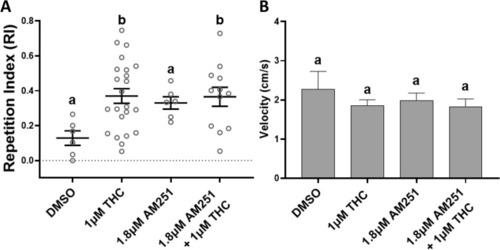- Title
-
THC-induced behavioral stereotypy in zebrafish as a model of psychosis-like behavior
- Authors
- Dahlén, A., Zarei, M., Melgoza, A., Wagle, M., Guo, S.
- Source
- Full text @ Sci. Rep.
|
( PHENOTYPE:
|
|
( PHENOTYPE:
|
|
Co-administration of Tetrahydrocannabinol (THC) and GABAA receptor antagonist pentylenetetrazol (PTZ) affects the THC-induced behavioral stereotypy in adult zebrafish. ( PHENOTYPE:
|
|
Co-administration of Tetrahydrocannabinol (THC) and the inverse CB1R agonist AM251 did not significantly reduce the THC-induced behavioral stereotypy in adult zebrafish. PHENOTYPE:
|
|
Co-administration of Tetrahydrocannabinol (THC) and the inverse CB2R agonist AM630 significantly reduced the THC-induced behavioral stereotypy in adult zebrafish. (A) At 3.5 μM AM630 with 1 μM THC the THC-induced Repetition Index (RI), calculated as a mean ± SEM, was not statistically different from the controls (DMSO) (ns p > 0.9999). (B) AM630 and THC co-administration did not affect the swimming velocity during exposure. Controls (DMSO 1%, n = 6), 1 μM THC (n = 23), 3.5 μM AM630 (n = 5) and 3.5 μM AM630 + 1 μM THC (n = 6). Values without a letter in common are statistically different to the control condition (p < 0.05, Kruskal–Wallis and Dunn's multiple comparisons test). |
|
Co-administration of Tetrahydrocannabinol (THC) and the atypical antipsychotic sulpiride significantly reduced the THC-induced behavioral stereotypy in adult zebrafish. ( PHENOTYPE:
|
|
Potential mechanisms underlying the associations between |







